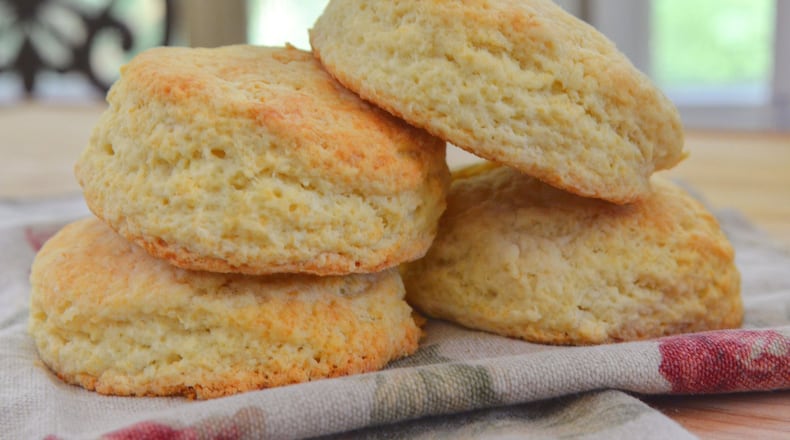My very first memory of baking was at the elbow of my grandmother, who would make biscuits for my family when we visited her small home in Corpus Christi, Texas. She would wake up before light to make biscuits. I stood on a kitchen stool as she cut the butter into the flour, added buttermilk and turned the mass into a workable dough. My job was to cut the biscuits with her round cutter, a treasure of hers that I still use today to cut my own biscuits.
Perhaps because we did it before dawn, perhaps because she never used a recipe, or perhaps because it was simply something I did with her that I did not have to share with my siblings, making biscuits was mysterious and sensual to me, even as a 6-year-old.
And while my grandmother’s intrinsic knowledge of baking baffles me even today, I doubt she ever thought much about the flour she used. There wasn’t much choice for her in pondering it: Unlike a lot of other things in her kitchen, flour was something she bought, and she bought what was available.
Today, there is so much more choice in flours it can be a little mind-boggling. While my grandmother most likely made her biscuits with a generic all-purpose flour ground from soft winter wheat, today I can choose not only from a variety of flours with varying gluten content (all-purpose, cake, bread, even OO flour from Italy); whole wheat; whole grain. I can also choose the grain used. A vanguard of seedsmen are preserving landrace — or heirloom — seeds that date back to Colonial times, using the sustainable farming methods our ancestors used, combined with the advanced technology available in 2019.
To make sense of what’s available to home bakers these days (via online ordering, not necessarily what’s on the shelf at your local grocer), it might help to have a general understanding of wheat.
Much of the wheat grown in the southern part of the United States prior to industrialization was soft red winter wheat — perfect for winter growing and spring harvesting. These wheats produce a grain that is lower in gluten, which is one reason biscuits are so popular in the South. The lower gluten content is perfect for the soft crumb needed for biscuits, cakes and pie crust.
"I never really paid much attention to various flours until the last decade as I've delved deeper into the subject," said Steven Satterfield, James Beard Award-winning chef at Miller Union, and author of "Root to Leaf: A Southern Chef Cooks Through the Seasons" (Harper Collins, 2015). "(When I was) growing up, my grandmother used White Lily Flour exclusively for her cakes and biscuits."
Satterfield has turned to landrace grain growers such as Glenn Roberts of Anson Mills in Columbia, South Carolina, to understand Southern wheat and other grains. He also orders from DaySpring Farms in Danielsville, Georgia, a USDA-certified organic mill in Madison County.
These seedsmen are reviving our “heritage” grains — those wheats, such as Red May and White Lammas — that were grown in the Colonies prior to the American Revolution. Like grapes for wine, these wheats were grown for flavor and vigor, and to invoke the terroir of their homesteads. Postwar industrialization of our agricultural products required that products be grown for transport and visual appeal — a fact that hasn’t changed much, even with the robust revival of these grains that began nearly 20 years ago.
Satterfield recommends experimenting with a mixture of flours. “Try playing around with different flours from Anson Mills or DaySpring Farms. Just remember that you will have to adjust your recipes so the first time may not be the outcome you would expect. (These flours have) very different properties than patented GMO milled flours.”
His favorite? “A version I made with Anson Mills Colonial Style Whole Wheat flour cut with a little all purpose from DaySpring Farms.”
SOUTHERN GRAIN MILLS
Other Southern mills that produce fine flour, but do not use landrace, or heritage grains:
Weisenberger Mill, Midway, Kentucky, owned and operated for six generations by the Weisenberger family, is nestled on the banks of the South Elkhorn Creek, in the heart of central Kentucky, where they produce flour, cornmeal and baking mixes. weisenberger.com.
RECIPES
These recipes call for the use of all-purpose flour, which has a gluten content of approximately 9% to 11% — perfect for the crumb needed in a soft biscuit. Try DaySpring’s organic all-purpose flour, or use Anson Mills’ White Lammas cake flour. Both can be purchased online.
Buttermilk Biscuits
These biscuits have a fine grain and soft crumb that make them perfect for breakfast with butter and honey or jam, or as the sidekick for classic chicken-fried steak and pan gravy.
Fluffy Biscuit Shortcakes
These light, fluffy, cake-like biscuits are a fine pairing for fruit shortcakes. Take advantage of the summer season and use fresh peaches and whipped cream or vanilla ice cream to layer with a split biscuit for the season’s perfect dessert. The dough can be baked in an 8-inch cake pan for one large shortcake, rather than individuals, if desired.
Lemon-Rosemary Tea Cake
This recipe, inspired by one found in Marion Cunningham’s “The Fannie Farmer Baking Book” (Alfred A. Knopf, 1984), is easy to make and produces a light tea cake with flour at its core, laced with rosemary and lemon. It’s perfect on its own or with a dollop of sweetened whipped cream. Feel free to serve it as a light dessert, afternoon snack or warmed for breakfast.
RELATED:
Read more stories like this by liking Atlanta Restaurant Scene on Facebook, following @ATLDiningNews on Twitter and @ajcdining on Instagram.
About the Author
Keep Reading
The Latest
Featured





